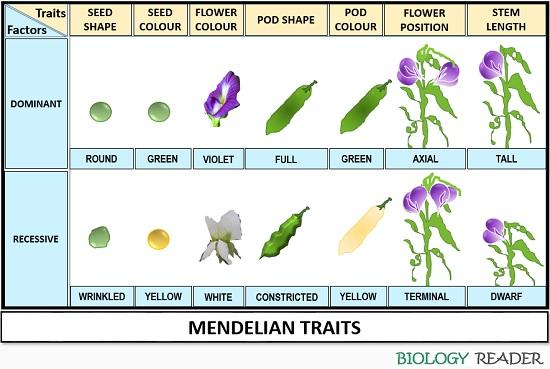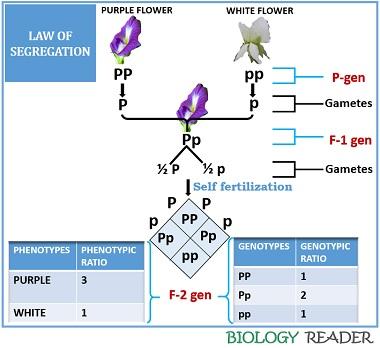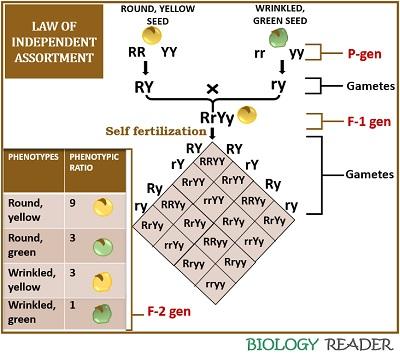Mendelian inheritance is an approach that explains the traits or characters inherit from one generation to another by the discrete units or genes. “Mendelism” or Mendelian inheritance was introduced by the Austrian monk Gregor Johann Mendel.
Sir Mendel has honoured as “Father of Genetics” for his great efforts to explain the theory of inheritance that is now popularly known as Mendelian inheritance or genetics.
To explain the theory of inheritance, Gregor Johann Mendel introduced three approaches, namely the law of dominance, law of segregation and law of independent assortment.
Sir Mendel performed experiments by taking a plant species (Pisum sativum or an ordinary garden pea) with different traits. In this context, we will learn the definition, mendelian traits, law of dominance, law of segregation and law of independent assortment.
Content: Mendelian Inheritance
Definition of Mendelian Inheritance
It refers to the theory of inheritance that postulates three generalizations by explaining the law of dominance, segregation and independent assortment. Mendel performed experiments in his monastery’s garden on a pea plant. According to the Mendelian inheritance and genetics:
- Traits: It refers to the features passed from the parent species to the new individuals by the carrier of discrete units.
- Genes: It refers to the discrete units, where each unit expresses itself independently in the offsprings.
- Alleles: It refers to the two alternative pairs of a gene, in which one pair from each parent is transferred to the offspring. If a gene carry two identical forms of alleles, an individual is said to have a “Homozygous genotype”. If a gene carry two different types (dominant and recessive) of alleles, an individual is said to have a “Heterozygous genotype”.
- Genotype: It refers to the specific arrangement of alleles for a given pair of genes. A dominant gene (represented by an uppercase letter ‘D‘) expresses its phenotypic characters significantly over a recessive gene (represented by a lower case letter ‘d‘).
- Phenotype: It refers to the visible traits of an organism like colour, length, and shape etc., that results after a gene expression.
Mendelian Traits
Mendel took seven different traits with two forms (dominant and recessive) in his experiment:

- Stem length: For such a character, Mendel took tall stem (dominant form) and dwarf stem (recessive form).
- Flower position: For such trait, he took flower on axial position (dominant form) and another on terminal position (recessive form).
- Flower colour: He took a violet coloured flower (dominant form) and a white coloured flower (recessive form) for such a trait.
- Pod shape: For such trait, Mendel took one inflated pod (dominant form) and constricted seed (recessive form).
- Pod colour: Mendel took a green coloured pod (dominant form) and a yellow coloured pod (recessive form).
- Cotyledon colour: Mendel took yellow coloured cotyledon (dominant form) and green coloured cotyledon (recessive form).
- Seed form: For such trait, Mendel took some round seeds (dominant form) and some wrinkled seeds (recessive form).
Reasons for Choosing Pea Plant
The ideal reasons for experimenting with Pisum sativum include:
- Easy cultivation: Mendel cultivated many generations of pea plant in his own monastery’s garden.
- Distinct traits: Mendel observed two distinct varieties of traits, for example, round and wrinkled form of seeds, purple and white flowers of pea plant etc.
- Cross-pollination: Generally, a pea plant can be self-pollinated but can also be cross-pollinated by transferring pollen from the flower’s anther of one plant to the flower’s stigma of another plant.
- Hermaphrodite flowers: A pea plant contains bisexual flowers having male and female reproductive parts both together.
- Germination time: Due to the short life cycle of a pea plant, they can grow within a short generation time that permit Mendel to upraise many generations of a pea plant.
Mendel Three Laws
Gregor Johann Mendel postulated some principles of inheritance, what we call “Mendel’s Law”. He described three laws of inheritance:
Law of Dominance
To explain the law of dominance, Mendel had given three postulates:
- Discrete factors or units direct phenotypic traits.
- The factors always comprise a couple of pairs are called “Alleles”.
- In two dissimilar alleles, one will show dominant characters, and the other will show recessive traits. The dominant factor will always mask the recessive form.
Therefore, the law of dominance is defined as the first law of inheritance that states the expression of only one form of a trait in the first filial generation during the monohybrid cross between the heterozygous genes. In the first filial generation, one parental gene will be expressed in offspring. In a second filial generation, both the parental characters will appear with a phenotypic ratio of 3:1.
Law of Segregation
Mendel introduced the law of segregation after performing experiments on different traits of a pea plant through a monohybrid cross to explain the law of dominance. The law of segregation is an explanation or the advanced view of the law of dominance.
It states that an individual carries two factors for a particular trait, which separate during the gamete formation, after which a gamete will take only a single factor. The discrete units of inheritance are the separate and distinct units that do not blend if present together.
This law is formulated for the diploid organisms that reproduce sexually and produce haploid gamete. To explain the law of segregation, Mendel postulated that:
- A gene carries a couple of alleles that are generally two in number.
- Gametes are produced after meiosis cell division, which will cause segregation of gene that remains each gamete with one member of an allele.
- An organism always inherited the two factors (dominant and recessive) for a single trait.
- If the two allelic pairs of the gene are different like (Tt), the dominant factor (T) will be expressed over the recessive factor (t). If the two allelic pairs of the gene are similar by possessing two dominant alleles, then genes will inherit homozygous dominant traits. Similarly, if the two allelic pairs of the gene possessing two recessive alleles, then genes will inherit homozygous recessive traits.
Example
Let us take a case by performing a monohybrid cross between the purple coloured (PP) and white coloured flower (pp) of a pea plant.

At the time of crossing over, a gene separates into distinct alleles where one factor from each parent will inherit into the F-1 progeny. ‘Pp’ will form in a first filial generation where a dominant factor (P) will conceal the phenotypic characters of a recessive allele (p).
On the self-pollination of F-1 progeny, we will observe the production of both purple coloured and white coloured flower with a phenotypic ratio of 3:1 and a genotypic ratio of 1:2:1. Law of segregation gives a brief on the law of dominance by focussing on some other approaches and explains the law of incomplete dominance.
Law of Incomplete dominance
After performing repeated experiments on pea plant, Mendel experimented on other plants by taking different traits. He found that the progeny formed in the F-1 generation did not show any features of the P-generation.
Example
To explain the law of incomplete dominance, Mendel performed crossing over between the red coloured (RR) and white coloured (rr) flowers of Antirrhinum species.

The two breeds ‘RR’ and ‘rr’, after crossing over, produced pink coloured flowers in the first filial generation with a genotype ‘Rr’. On self-pollination of ‘Rr’, the genotype ratio (1:2:1) will be the same as the law of dominance, but the phenotypic ratio (3:1) will change into 1:2:1.
Mendel concluded that the dominant allele of the ‘Rr’ gene would not dominate entirely over the recessive allele that resulted in the formation of pink snapdragon flower in place of red.
Law of Independent Assortment
Mendel proposed a law of independent assortment by experimenting with a dihybrid test cross of two independent traits. According to this law:
- The assortment of a single paired gene is independent of the other pair at the time of gametogenesis.
- Each pair of a gene will express their phenotypic characters differently and independently.
Example
Test cross between the pea plants having round, yellow seed with the wrinkled, green seed.

After crossing over, all round, yellow seeds will produce in the first filial generation. When the F-1 hybrid plants are allowed for self-fertilization, we could see the inheritance of independent seed colour characteristics from the original varieties.
- The following phenotypic variations will obtain: Round, yellow (9): Round, green (3): Wrinkled, yellow (3): Wrinkled, green (1).
- The genotypic ratio obtained in the second filial generation is RRYY (1): RRYy (2): Rryy (1): RrYY (2): RrYy (4): Rryy (2): rrYY (1): rrYy (2): rryy (1).
After performing such a dihybrid cross, Mendel concluded that the segregation of the seed colour is independent of the seed shape. It results in the evolution of new characters and some parental characters in the offsprings.
Conclusion
Initially, Mendel’s theory faced many controversies and rejections and not accepted by many scientists. The Mendel experiment became successful when T.H. Morgan and his co-workers compared the Mendelian model with the chromosomal model of inheritance.
They concluded that the chromosomes are the actual carriers of such discrete factors, what we now call genes. Mendelism is one of the popular theory in genetic science that explain the factors of inheritance.